Collaboration Platform: Unlocking $1.6T of Value in the World’s Largest and Poorest-Performing Industry: Construction

The construction industry is the largest industry in the world, the poorest-performing, and the largest contributor to GHG emissions. Approaches and practices have not changed appreciably in 100 years. This industry is complex, fragmented, and siloed because of significant risks in a world of low profit margins. A collaboration solution is needed to address the growing need to better use existing buildings, mitigate GHGs, and unlock $1.6T of pent-up productivity value.
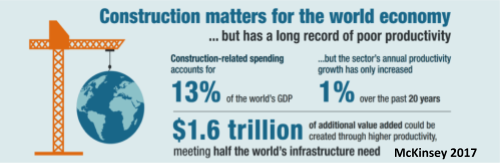
Vision and value proposition
Our vision is to unlock the value of the construction industry to make better buildings, through modernization, digitization, and enabling collaboration to harness the creativity and productivity of the construction community.
The problem
The construction industry is the largest global sector (13% of the global GDP), lowest performing (1% productivity growth in the last 20 years) (McKinsey 2020), and largest contributor to GHG emissions (~40%) (UN environment 2017).
McKinsey (2017) estimated $1.6T of value that could be created through increased productivity and reduced waste. The construction industry is also figuring out how to best renovate and adapt abandoned and under-used buildings (e.g. Big-Box stores).
Why is this poor performance happening?
- The construction industry is extremely fragmented and siloed, with low profit margins, high risk aversion (in part due to assuming the majority of the project risks).
- The construction industry has not appreciably changed how we do our work for 100 years. Yes, we added some tools and technologies but only for some work and only with some companies. The underlying approaches have not changed.
- Projects are complex, bespoke, and ultimately super-local and there is an increasing disconnect between what customers want (faster, cheaper, better, global) and our ability to deliver.
 This is a map of the construction industry technology ecosystem (McKinsey 2018). This shows the linkages between technology components, everything from document management to software to AI. It’s also a good portrayal of the complexity of this industry. It’s important to understand that this linkage often does not occur within companies (note all the thin lines) and almost never occurs across companies.
This is a map of the construction industry technology ecosystem (McKinsey 2018). This shows the linkages between technology components, everything from document management to software to AI. It’s also a good portrayal of the complexity of this industry. It’s important to understand that this linkage often does not occur within companies (note all the thin lines) and almost never occurs across companies.
Here’s what our clients say about this problem:
- How can I learn about my peers’ key successes, failures, and tools so I can skip the trial and error and get faster, cheaper, WISER, to keep increasing the value to my company without killing myself and my team?
- Why won’t you work with each other to solve my problems?
- You have thousands of employees-why do you keep missing deadlines and going over budget?
- Why do you keep bringing me the same stale solutions?
- Why did you sell me a global solution and then give me a local one that I could’ve bought myself?
Target market and opportunity
We serve two groups of customers:

The market size is:
- 2020: $12.6T
- 2030: $15.6T
- Pent-up Productivity Value: $1.6T
(Data : Business Research Company, 2020, McKinsey, 2020)
The solution
The solution is a digital platform: BuildSTACK, a Collaboration Platform for Building Construction Stakeholders, Technology, Analytics, Collaboration, and Knowledge. Each of the components was selected based on feedback from multiple Owner and Supplier users.
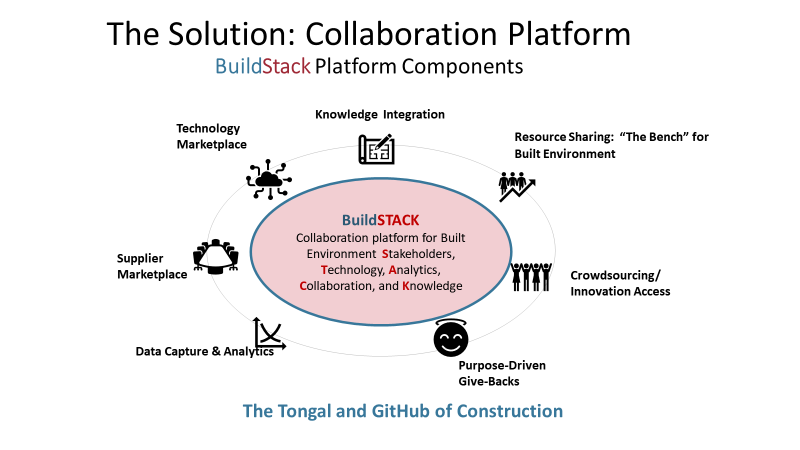
Platform Components:
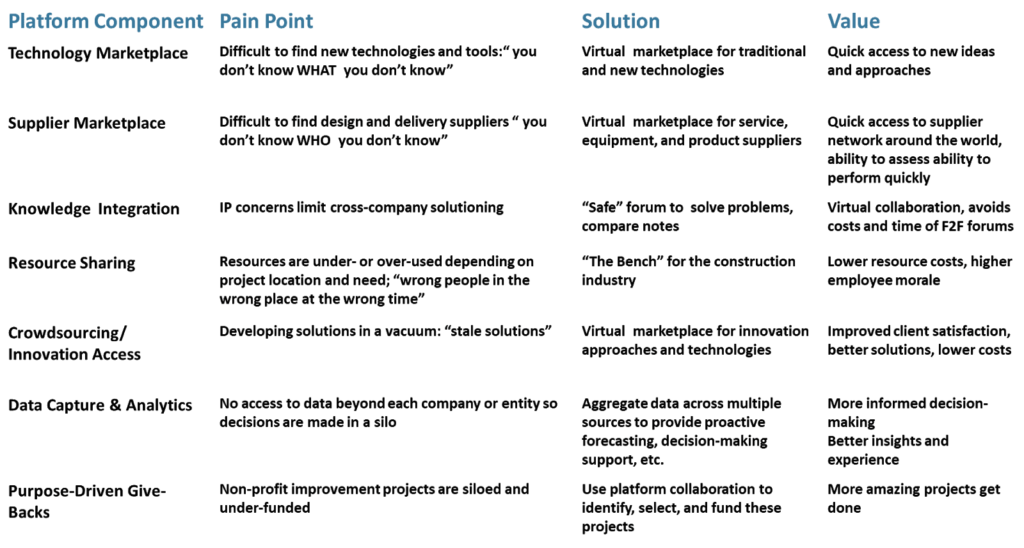
This platform will enable connections across the construction industry. These connections are currently difficult and somewhat random. It will allow the full range of companies to access services and tools:
- Owners and investors
- Small niche supplier companies that are providing some of the skilled resources
- Dominator supplier companies, who need better ways to get at suppliers and niche companies
- Regulators and NGOs who want more transparency and better clarity on project activities and outcomes.
This also makes people more transportable in the industry and will enable remote working to be more efficient and effective by linking groups together easily.
Platform Business Model:
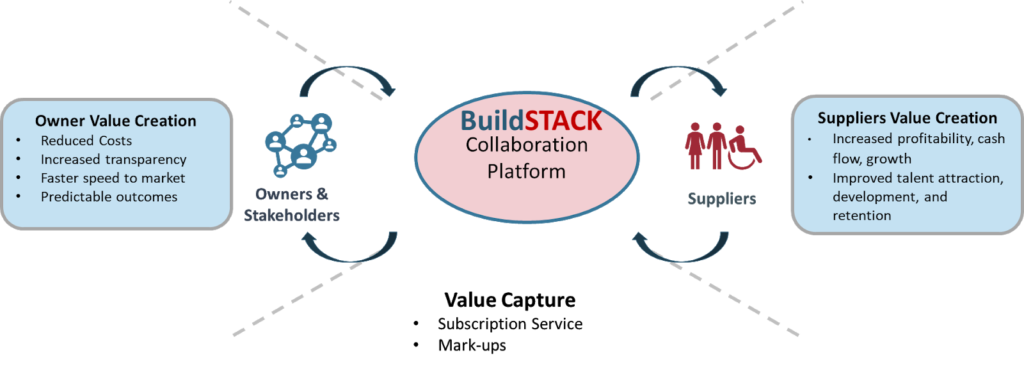
We’ve been testing this platform concept with many potential users from the Owner and Supplier side. Here is an example of an “early adopter” of this platform (this is what this company called themselves) and the value they anticipate from this platform:
Team:
We are developing this out. Currently, our contributors consist of:
- Susan Shultz*: Owner, Industry Executive
- Tara Kassal: Ascent CEO (early adopter)
- Conrad Warmbold*: Product development
- Dean and Craig Marris*: Advisors
- Katelyn Dowling*: Advisor
- DJ Ursal*: Advisor
- Stephen Yohannan*: Potential partner
*HBAP
- Many clients and colleagues in the construction industry.
Competition:
There are multiple competitors in the market today. What’s interesting is that they are providing pieces of the solution, but still not addressing the need to reduce the friction and noise by providing information and ability to collaborate in one easy place.
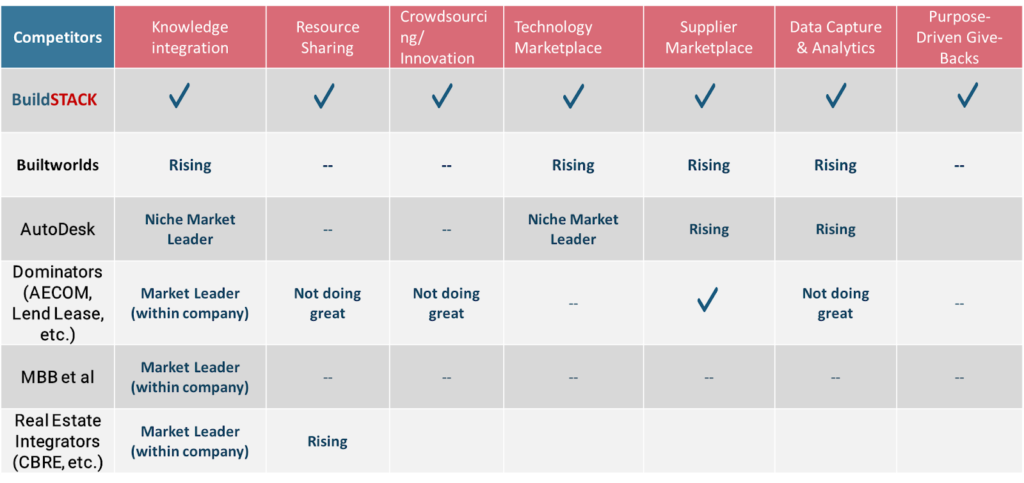
The BuildSTACK platform is different because all of the key enabling components are in one place, causing streamlined and more efficient information sharing, access to new ideas, access to better technology and a larger supplier base, as well as the ability to use data proactively to streamline decision-making throughout the construction lifecycle. In addition, the ability to “crowdsource” give-back and charity programs will be attractive to many industry people.
Thank you
Thank you to all the students, Teaching Fellows, professors, and other HBAPers in Cohort 10 and Immersion 1 who had great questions, ideas, and ways to make this better!



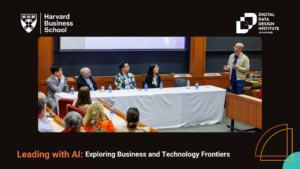
Susan, very well research and presented. You got my interest immediately when looking to reduce greenhouse gas and waste/costs. My hope would be that people would be willing to share their learns from their mistakes
Great job Susan. You’ve condensed a great deal of information into a digestible format to present both the problem and the benefit of your solution. It will be a challenge to change such an old and large industry but you’ve made a strong case for the benefit of doing just that. I also like the flexibility of the platform to allow for investing in certain components.